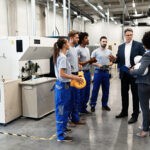Prevention is better than cure” can be rephrased in the purview of data science as “Prediction is better than cure”. Building models with historical data using ML (Machine Learning) algorithms play a key role to predict the future instance.
In 15th century, lived a man named Leonardo di ser Piero da Vinci, who possessed unlimited, standing to all areas of human knowledge and skill – artist, scientist, anatomist, sculptor, botanist, architect, musician, engineer, inventor, entertainer and philosopher”. He carved images of helicopter, Parachute, etc… Later in 19th century it came into reality. Thus, Leonardo’s imagination turned into prediction sounds like a cliché for…
“Imagination is more important than knowledge” – Einstein
Today’s 4.0 Industrial Revolution needs more of imagination to deal with enormous amount of data, to build use-cases and applications. The set of Machine Learning algorithms are used to derive predictions as same as the Leonardo’s imagination which came true.
 |  |
Machine Learning Algorithms
Classification:
Classification is the problem of identifying to which set of categories (i.e., sub-populations) a new observation belongs.
Example: Consider a conveyor belt from which different colour of product are being segregated.
Regression:
Regression analysis is a set of statistical processes for estimating the relationships among variables between a dependent variable and one or more independent variables.
Example: If number of employee is increased what will be the productivity? What will be the productivity timeline?
Time Series:
A time series is a series of data points indexed in time order. It is a sequence taken at successive equally spaced points in time. Thus it is a sequence of discrete-time data. Time series forecasting is the use of a model to predict future values based on previously observed values.
Example: Using Chillers Historical data, the future instance of value of a parameter can be predicted.
Neural Network:
A neural network is a series of algorithms that endeavors to recognize underlying relationships in a set of data through a process that mimics the way the human brain operates. Neural networks can adapt to changing input so the network generates the best possible result without needing to redesign the output criteria.
Example: Amazon uses Unmanned Aerial Vehicles for delivery, Tesla uses self-driving cars which learns the patterns as human behaves and works on its own.
Random Forest:
Random forests are an ensemble learning method for classification, regression and other tasks, that operate by constructing a multitude of decision trees at training time and outputting the class that is the mode of the classes (classification) or mean prediction (regression) of the individual trees.
Example: Determining beverage quality through factors such as acidity, sugar, sulfur dioxide levels, pH value and alcohol content.
We at Maxbyte Technologies build automation and standardization for data science process for industrial equipment analytics requirements and make predictive analytics process more efficient. Want to know more? click here.




